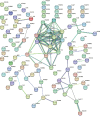Network analysis for identifying potential anti-virulence targets from whole transcriptome of Pseudomonas aeruginosa and Staphylococcus aureus exposed to certain anti-pathogenic polyherbal formulations
- PMID: 37275512
- PMCID: PMC10238913
- DOI: 10.33393/dti.2023.2595
Network analysis for identifying potential anti-virulence targets from whole transcriptome of Pseudomonas aeruginosa and Staphylococcus aureus exposed to certain anti-pathogenic polyherbal formulations
Abstract
Introduction: Antimicrobial resistance (AMR) is a serious global threat. Identification of novel antibacterial targets is urgently warranted to help antimicrobial drug discovery programs. This study attempted identification of potential targets in two important pathogens Pseudomonas aeruginosa and Staphylococcus aureus.
Methods: Transcriptomes of P. aeruginosa and S. aureus exposed to two different quorum-modulatory polyherbal formulations were subjected to network analysis to identify the most highly networked differentially expressed genes (hubs) as potential anti-virulence targets.
Results: Genes associated with denitrification and sulfur metabolism emerged as the most important targets in P. aeruginosa. Increased buildup of nitrite (NO2) in P. aeruginosa culture exposed to the polyherbal formulation Panchvalkal was confirmed through in vitro assay too. Generation of nitrosative stress and inducing sulfur starvation seemed to be effective anti-pathogenic strategies against this notorious gram-negative pathogen. Important targets identified in S. aureus were the transcriptional regulator sarA, immunoglobulin-binding protein Sbi, serine protease SplA, the saeR/S response regulator system, and gamma-hemolysin components hlgB and hlgC.
Conclusion: Further validation of the potential targets identified in this study is warranted through appropriate in vitro and in vivo assays in model hosts. Such validated targets can prove vital to many antibacterial drug discovery programs globally.
Keywords: AMR (antimicrobial resistance); Anti-virulence; Network Analysis; Novel antibacterial targets; Polyherbal; Protein-Protein Interaction (PPI).
Copyright © 2023, The Authors.
Conflict of interest statement
Conflict of interest: The authors declare no conflict of interest.
Figures








Similar articles
-
Deciphering the molecular mechanisms underlying anti-pathogenic potential of a polyherbal formulation Enteropan® against multidrug-resistant Pseudomonas aeruginosa.Drug Target Insights. 2024 Aug 30;18:54-69. doi: 10.33393/dti.2024.3082. eCollection 2024 Jan-Dec. Drug Target Insights. 2024. PMID: 39224464 Free PMC article.
-
Anti-infective potential of a quorum modulatory polyherbal extract (panchvalkal) against certain pathogenic bacteria.J Ayurveda Integr Med. 2020 Jul-Sep;11(3):336-343. doi: 10.1016/j.jaim.2017.10.012. Epub 2018 Oct 24. J Ayurveda Integr Med. 2020. PMID: 33012317 Free PMC article.
-
Validation of the anti-infective potential of a polyherbal 'Panchvalkal' preparation, and elucidation of the molecular basis underlining its efficacy against Pseudomonas aeruginosa.BMC Complement Altern Med. 2019 Jan 17;19(1):19. doi: 10.1186/s12906-019-2428-5. BMC Complement Altern Med. 2019. PMID: 30654785 Free PMC article.
-
Pseudomonas aeruginosa and Staphylococcus aureus communication in biofilm infections: insights through network and database construction.Crit Rev Microbiol. 2019 Sep-Nov;45(5-6):712-728. doi: 10.1080/1040841X.2019.1700209. Epub 2019 Dec 13. Crit Rev Microbiol. 2019. PMID: 31835971 Review.
-
Structure-based Druggability Assessment of Anti-virulence Targets from Pseudomonas aeruginosa.Curr Protein Pept Sci. 2019;20(12):1189-1203. doi: 10.2174/1389203720666190417120758. Curr Protein Pept Sci. 2019. PMID: 31038064 Free PMC article. Review.
Cited by
-
Deciphering the molecular mechanisms underlying anti-pathogenic potential of a polyherbal formulation Enteropan® against multidrug-resistant Pseudomonas aeruginosa.Drug Target Insights. 2024 Aug 30;18:54-69. doi: 10.33393/dti.2024.3082. eCollection 2024 Jan-Dec. Drug Target Insights. 2024. PMID: 39224464 Free PMC article.
-
Identification of anti-pathogenic activity among in silico predicted small-molecule inhibitors of Pseudomonas aeruginosa LasR or nitric oxide reductase (NOR).Drug Target Insights. 2023 Sep 28;17:101-109. doi: 10.33393/dti.2023.2638. eCollection 2023 Jan-Dec. Drug Target Insights. 2023. PMID: 37811195 Free PMC article.
-
Sub-lethal concentration of a colloidal nanosilver formulation (Silversol®) triggers dysregulation of iron homeostasis and nitrogen metabolism in multidrug resistant Pseudomonas aeruginosa.BMC Microbiol. 2023 Oct 23;23(1):303. doi: 10.1186/s12866-023-03062-x. BMC Microbiol. 2023. PMID: 37872532 Free PMC article.
References
LinkOut - more resources
Full Text Sources

